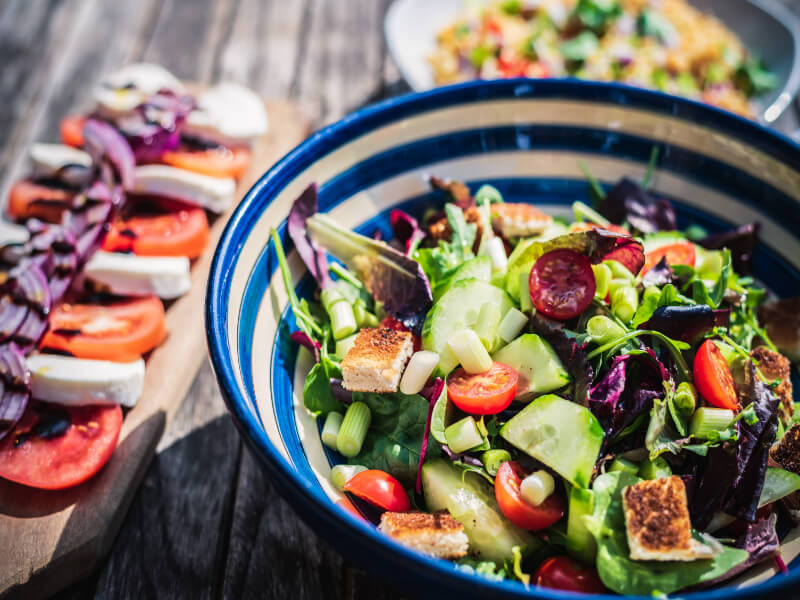Keto Diet for Beginners: Ultimate Keto Guide [2023]
Table of Content
The Keto diet is a low-carb, high-fat way of eating that aims to put your body into a state of ketosis. The main idea behind the Keto diet is to significantly reduce your carbohydrate intake and replace it with healthy fats. This change in macronutrient balance causes your body to start burning fat for fuel instead of glucose from carbohydrates. This metabolic state, known as ketosis, can lead to various health benefits, including weight loss. This guide is intended for beginners who are looking to start the Keto diet and improve their overall health and wellness.

What is Keto Diet?
The Keto diet is a low-carb, high-fat dietary approach that has gained popularity in recent years as a way to promote weight loss and improve overall health. The primary goal of the Keto diet is to put the body into a metabolic state known as ketosis, where it begins to burn stored fat for energy instead of glucose from carbohydrates. By reducing carbohydrate intake and increasing fat intake, the Keto diet helps the body enter and maintain ketosis, leading to various health benefits.
The Keto diet’s effectiveness is largely dependent on the balance of its macronutrients. The recommended macronutrient balance for the Keto diet is around 70–75 percent fat, 20–25 percent protein, and 10–15 percent carbs. The body enters a state of ketosis as a result of the right amount of fat and carbohydrate consumption, which is balanced. You should monitor your macronutrient consumption to make sure you are successfully adhering to the Keto diet.
Understanding what foods are allowed and what should be avoided is essential while following the Keto diet. Protein-rich foods like meat, fish, and chicken as well as wholesome fats like avocados, olive oil, and coconut oil are among the foods to eat. You should also include low-carb vegetables like spinach, broccoli, and cauliflower in your diet. Starchy vegetables like potatoes and maize, as well as other sweet and processed meals, should be avoided. To get the best effects from the Keto diet, it’s crucial to concentrate on full, unprocessed meals.

How does Keto Diet Work?
The Keto diet works by drastically reducing the intake of carbohydrates and increasing the consumption of healthy fats. This shift in macronutrient balance puts the body in a metabolic state known as ketosis, where it starts to burn fat for energy instead of carbohydrates. The lack of carbohydrates causes the liver to produce ketones, which are used as fuel by the body. As a result, the body is able to access its stored fat and burn it for energy, leading to weight loss.
In the Keto diet, the recommended macronutrient ratio is typically 70-75% healthy fats, 20-25% protein, and 5-10% carbohydrates. By reducing carbohydrate intake and increasing fat intake, the body is able to access its stored fat and use it as fuel, leading to weight loss. Additionally, the Keto diet has been shown to have numerous health benefits, such as improved insulin sensitivity, reduced inflammation, and improved heart health. It is important to note that the Keto diet should be done under the supervision of a healthcare professional and with the support of a balanced meal plan.
Advantages of Keto Diet
For those who accurately and continuously follow it, the Keto diet has advantages. Losing weight is one of the most prominent benefits. The body enters a state of ketosis, when it starts to use fat reserves for energy, by consuming less carbohydrates and more fat. Weight reduction may result from this change in metabolism. The Keto diet has also been demonstrated to enhance blood sugar regulation and reduce the chance of developing certain illnesses, including type 2 diabetes and heart disease. It can also increase energy and brain function. Additionally, the Keto diet may result in increased focus and mental clarity.
Additionally, a lot of people discover that the Keto diet improves their general health and wellbeing, including better digestion, greater energy, and better sleep.

Getting Started with Keto Diet for Beginners
Meal planning is an important part of starting the Keto diet, as it helps ensure you are getting the correct balance of macronutrients and eating the right foods to enter and maintain ketosis. To get started with meal planning, consider your daily caloric needs, macro goals, and food preferences. You can use online tools to help with this or consult a dietitian for personalized guidance.
Once you have your meal plan in place, make a grocery list of the necessary ingredients and try to stick to it when shopping. This will help ensure that you have the right foods on hand to prepare healthy, Keto-friendly meals.
When grocery shopping for the Keto diet, it’s important to focus on high-fat, low-carb foods. A good grocery list for the Keto diet might include healthy fats like coconut oil and olive oil, proteins like meat, fish, and poultry, and low-carb vegetables like spinach, broccoli, and cauliflower. Avoid purchasing processed and high-carb foods, such as sugary snacks and starchy vegetables like potatoes. Instead, opt for whole, unprocessed foods to support your Keto diet.
Eating out can be a challenge when following the Keto diet, as many restaurants offer high-carb, processed foods. To make eating out a success, plan ahead and look for restaurants that offer Keto-friendly options. When ordering, be sure to ask for your meal to be prepared without any added sugars or starchy ingredients. Consider ordering dishes that are high in healthy fats and proteins, such as grilled chicken or steak with a side of vegetables.
Avoid dishes that are high in carbohydrates, such as pasta, rice, and bread. With a little planning and effort, you can enjoy eating out while still following the Keto diet.
Main Challenges with Keto Diet for Beginners
The Keto flu is a common challenge experienced by those starting the Keto diet. It is caused by the body adjusting to the shift in energy sources from carbohydrates to fats. Symptoms of the Keto flu include headaches, fatigue, nausea, and muscle cramps. To combat the Keto flu, make sure you are getting enough electrolytes, such as salt, potassium, and magnesium. Increasing fluid intake can also help. Eating Keto-friendly foods that are high in healthy fats and protein can also provide the energy and nutrition needed to overcome the Keto flu.
Lack of energy is another common challenge faced by those starting the Keto diet. This can be due to the body adjusting to the shift in energy sources, or it could be a result of not eating enough or not eating the right balance of macronutrients. To combat a lack of energy, make sure you are eating enough calories and getting the right balance of macronutrients. Incorporating healthy fats and proteins into your meals can also help to boost energy levels. If you are still experiencing a lack of energy, consider speaking with a healthcare professional or a dietitian for personalized guidance.
Sticking to the Keto diet can be difficult, especially for beginners. This can be due to temptations from friends, family, or social events, or simply a lack of knowledge about what foods are Keto-friendly. To overcome this challenge, find a support system, such as friends or family members who are also following the Keto diet, or join a Keto community online. Plan ahead for social events and bring Keto-friendly foods with you, or find Keto-friendly options at the event. Finally, educate yourself on the Keto diet, including what foods are allowed and what foods to avoid, to help make sticking to the diet easier.

Common Mistakes of Keto Diet
One of the common mistakes people make when starting the Keto diet is not properly tracking their macro intake. It’s important to ensure that you are consuming the recommended ratio of healthy fats, protein, and carbohydrates. Failing to do so can result in not entering ketosis, which is necessary for the diet to be effective. Another common mistake is not eating enough healthy fats, which can lead to hunger and cravings.
Another common mistake is not properly planning meals and not having access to healthy Keto-friendly options when eating out. This can lead to reaching for unhealthy, high-carb options, which can kick you out of ketosis and undermine your progress. Additionally, some people may also fall into the trap of relying on processed Keto-friendly foods, such as keto bars and shakes, instead of whole, nutrient-dense foods. This can lead to nutrient deficiencies and health issues over time. To avoid these common mistakes, it’s important to educate yourself on the Keto diet, plan your meals, and seek the guidance of a healthcare professional.
Supplements on Keto Diet
While the Keto diet can be highly effective for weight loss and improved health, some people may choose to supplement their diet with additional vitamins and minerals to ensure they are getting all the nutrients they need. This can be especially important for those who may not be able to consume certain food groups, such as leafy greens, which are high in important nutrients like magnesium and potassium.
Common supplements for the Keto diet include magnesium, potassium, and sodium. Magnesium helps with energy production and muscle function, while potassium is important for heart health and muscle function. Sodium helps regulate blood pressure and fluid balance. Additionally, some people may choose to supplement with a multivitamin to ensure they are getting all the essential vitamins and minerals they need. It is important to note that supplements should be used in conjunction with a balanced diet and under the guidance of a healthcare professional.

Make Keto Diet your Lifestyle
Staying motivated can be a challenge for anyone, but it’s especially important when starting a new diet like the Keto diet. To stay motivated, set achievable goals and track your progress. Celebrate your successes, no matter how small they may be, to keep you on track. Consider finding a accountability partner or joining a support group to help keep you motivated. Finally, be kind to yourself and remember that progress is not always linear.
Incorporating physical activity into your lifestyle can help support your Keto diet goals. Regular exercise can boost energy levels, help with weight loss, and improve overall health. To get started, find an activity that you enjoy and make it a part of your daily routine. This can be anything from going for a walk, to weightlifting, to participating in a sport. Regular physical activity can also help to reduce stress and improve mental health, which can be important for maintaining a healthy lifestyle.
Finding support is crucial when making the Keto diet a lifestyle. Support can come from many sources, such as friends and family, a support group, or an online community. Having a support system can help you stay motivated, offer advice and encouragement, and hold you accountable. Joining a support group or online community can also provide a sense of community and help you connect with others who are on a similar journey. Don’t be afraid to reach out for support when you need it, as it can be a valuable tool for success.
Summary for Keto Diet for Beginners
In conclusion, the Keto diet can be a powerful tool for weight loss, improved health, and increased energy. However, starting the Keto diet can be challenging, especially for beginners. Understanding the Keto diet, including the definition, macros, and foods to eat and avoid, is crucial for success. Meal planning, grocery shopping, and tips for eating out can also help make the transition to the Keto diet easier.
Common challenges, such as the Keto flu, lack of energy, and difficulty sticking to the diet can be overcome with the right support and strategies.
Finally, making the Keto diet a lifestyle requires staying motivated, incorporating physical activity, and finding support. With the right mindset and resources, anyone can successfully incorporate the Keto diet into their lifestyle and enjoy the many benefits it offers.




